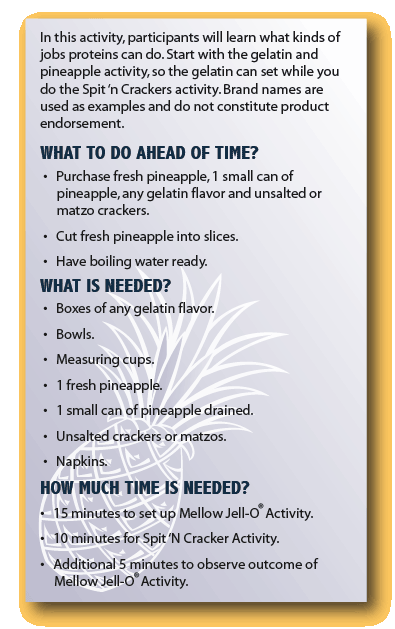
Activity 4.1: Mellow Jell-O®
and Spit ‘N Crackers

Directions
Mellow Jell-O®
Start this activity first to allow gelatin to set up before participants end the activity. Divide participants into groups. Ask half of the groups to make gelatin with fresh pineapple; the other half with canned pineapple. Follow directions on the gelatin box for making the liquid gelatin. Divide the liquid gelatin into enough bowls so that each group has one bowl. Ask some groups to add several chunks of fresh pineapple to their bowl and the other groups to add several chunks of canned pineapple. Thoroughly stir both and refrigerate. Observe results after gelatin sets up.Spit 'N Crackers
After gelatin activity is underway, have participants be seated and give each participant a soda cracker. Have them put it in their mouths and chew. DO NOT SWALLOW. After chewing for 30 seconds, ask participants to describe what taste the crackers have. Then ask them to continue chewing WITHOUT swallowing. After 2 minutes of chewing, ask them again to describe the flavor of the cracker. It is important to use unsalted crackers or matzo because they contain less sugar and salt and thus will have no initial salty or sweet taste.After the Spit 'N Cracker Activity share with the group the following. Remind them that DNA contains the information that gives an organism its special characteristics, like colors, tastes and smells. The chemical bases in DNA, A,G,C,T, are used to copy another very important informational chemical, called RNA. RNA is complementary to DNA so that every G in the DNA is matched by a C in the RNA copy. Every C is matched by a G; T with an A and every A with a U. The U substitutes for T in RNA. The code in RNA is the information the cell uses to make proteins.
- Describe what kinds of functions proteins might perform?
- Explain why the taste of the cracker changed after you chewed on a cracker for several minute? Hint to Leader: Amylase, an enzyme which degrades starch into sugars, is present in our saliva and changes cracker starch into sugar. Sugars taste sweet; starch doesn't. Breaking down starches to sugars is necessary for the body to use the starch for energy.
- How do you think the cell is able to make so many different proteins of different functions? Hint to Leader: The number and sequence in which amino acids are hooked together determine a protein's size and its function. Cells hook amino acids together, just like cars in a train are hooked together; the result is called a protein.
After completing the Spit 'N Cracker activity, have participants check the results from their Mellow Jell-O® Activity. When considering the Mellow Jell-O® Activity, share the following. The ingredient in Jell-O® that makes it wobbly is actually a protein, called gelatin. When it is dissolved in hot water and allowed to cool, the proteins link together like strings in a net to make the mixture solid.
- Explain why you think the gelatin did not solidify when you added fresh pineapple?
- Why do you think canned pineapple did not give the same result? Hint to Leader: The gelatin didn’t become wobbly when fresh pineapple was added
 because there is an enzyme in fresh pineapple that breaks the long protein chains that makes the gelatin strings break into shorter pieces. The heat used to can pineapple destroys the enzyme that breaks down the gelatin.
because there is an enzyme in fresh pineapple that breaks the long protein chains that makes the gelatin strings break into shorter pieces. The heat used to can pineapple destroys the enzyme that breaks down the gelatin.
Next: Activity 4.2: Genetically Modified Hopscotch (optional)
